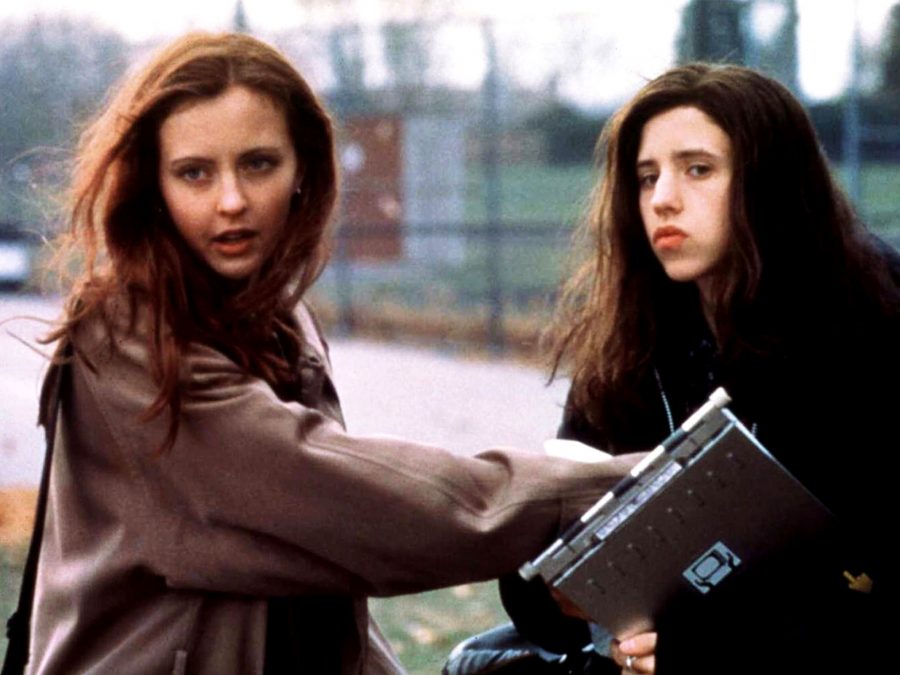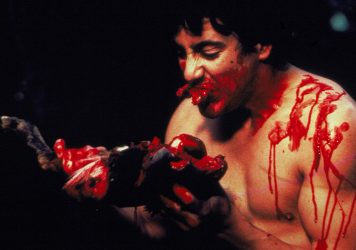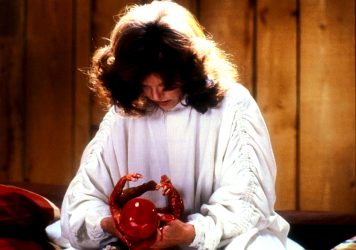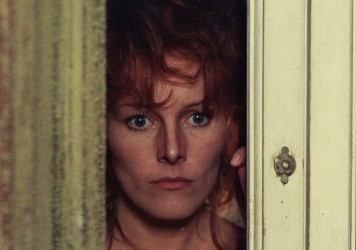
“You don’t think our deaths should be more than cheap entertainment?” In a complex film that combines horror, teen girl politics, coming-of-age, bodily transformations and family bonds, this is the closest Ginger Snaps gets to a statement of intent. Brigitte (Emily Perkins) and Ginger Fitzgerald (Katharine Isabelle) are not here to run an obstacle course of survive or die. They are not your usual final girls.
Ginger Snaps was well-received on the festival circuit, premiering at the Fantasy Film Festival in Munich before playing at the Toronto International Film Festival and various genre festivals. But it fared less successful upon wider release, initially struggling to reach its intended audience. Slowly, over time, the Fitzgeralds found their crowd.
Released 20 years ago, Ginger Snaps is a bloody love letter to teenage girls everywhere. Rooted in riot grrrl culture, it falls into a long history of progressive and transgressive Canadian horror films: Black Christmas laid the blueprint for slasher films; David Cronenberg’s early body horrors Rabid and Shivers drew controversy for being publicly funded, as would Ginger Snaps. In the late 1990s and early ’00s, horror films (mostly from the US), re energised by Wes Craven’s Scream, was all about teenagers – but not the teenage experience.
As well as subverting various horror conventions, Ginger Snaps also provides a sharp feminist critique of the genre. Yet behind the clever metaphors, gnarly creature effects and quotable dialogue is the captivating relationship between the Fitzgerald sisters.
The opening credits are a series of graphic faked suicide scenarios (very DeviantArt circa the early-2000s). The languid theme song could very well be a lonely teenager’s bedroom cover of a Bauhaus track. This is our introduction to Brigitte and Ginger, and crucially it’s presented from their point of view. Like any teenagers stuck in suburbia, they hate everything around them: it’s not that they have a death wish, more that they will only accept reality on their terms.
At the start of the film, they are actively hiding themselves. They smoke and sulk, hunched over in their oversized dark hoodies, trying to make themselves disappear. The suicide montage is their school project and pits them against not just their classmates, who already see them as weird, but also their teacher, who seems legitimately afraid of them.
They are foul-mouthed, morbid, and unapologetically themselves. “They are dark-minded girls because that’s the kind of girl I thought wasn’t being given the opportunity. Intelligent, critical thinkers who had their own ideas about the world, who had their own lives and their own thoughts on what was acceptable,” screenwriter Karen Walton tells me.
The language the sisters use is aggressive, expletive-ridden and faithful to how teenagers speak. It’s a conscious refusal to be sexualised, to be polite, to be nice. “Horror is often the return of the repressed, and Ginger Snaps is a good example of repressed sexual energy threatening mainstream culture,” says Perkins, who plays Brigitte.

This was Walton’s first script, and she had to be convinced to write it by the film’s director, John Fawcett. They were living together at the time, and Fawcett was fascinated by the idea of making a film about transformation, which naturally pointed him towards werewolves. “At first I was resistant because they were all so cheesy and stupid,” he recalls. “There were no good examples, except maybe An American Werewolf in London. The more I thought about it, the more I realised there were no female werewolf [movies] I’d seen.”
The Ginger Snaps team were all suburban kids. Todd Cherniawsky, the production designer, was an old friend of Walton’s; Fawcett and cinematographer Thom Best were from the same area, as was the composer, Michael Shields. The film is inspired by, and satirises, suburban life. A neat row of houses, white picket fences and polite neighbours, all drawn from the filmmakers’ own experiences growing up in smalltown Canada It’s an environment that is way too dull, too normal, for the Fitzgeralds.
From the outset, they were always meant to be sisters; initially twins. But with twins still widely associated with the supernatural (at least on screen), that idea was quickly dropped. The relationship between them is complex, codependent and ripe for conflict. “There is a power structure here in which Big Sister has protected and cared for Little Sister, and Little Sister has grown to depend on that – and so has Big Sister,” says Walton. As Isabelle sees it, Ginger Snaps is “a beautiful, tragic love story.”
Their mother, Pam (Mimi Rogers), is the quintessential suburban mom, desperately trying to forge a connection with her daughters. “Her last great hope for the revival of a meaningful emotional connection,” says Walton, “is someone getting their period.” The other girls in their school are led by proto-mean girl Trina (Danielle Hampton), the type of popular girl who is outwardly nasty. “Brigitte feels betrayed by all the female characters in the film,” explains Perkins, “their allegiance is to patriarchal values because they are rewarded for upholding them.” Their inability and unwillingness to fit into this fixed system of femininity isolates them still further. The sisters stand alone.
Ginger and Brigittes’ bedroom is their world, as indeed all teenage bedrooms are. They live in a basement, dank and grim but ideal for putting as much space between them and the rest of their family. They decorate the space with shiny purple beaded curtains, green candles and pictures of themselves in death poses. “I liked the idea that they shared side by side beds as though they were in a hospital or an institution together,” says Fawcett. The symmetry of their two beds visually conveys their togetherness. “Out by 16 or dead on the scene but together forever,” is their pact, “United against life as we know it.” For any goth-punk-emo kid watching Ginger Snaps for the first time, the Fitzgerald sisters are aspirational weirdos.
“As a werewolf, Ginger weaponises her new desirability to lure young men to their deaths. Her body becomes a warzone to her, a desirable object to others, and a monster to be vanquished.”
When Ginger is bitten by a wolf on the day of her first period, her transformation begins. Everything she goes through is an extension of puberty. Her physical transformation is slow, evolving from concealable elements like coarse hairs and a tail before her entire body morphs into a grotesque, white-haired were-woman and, eventually, a wolf. Her emotional transformation sees her become more sexually aggressive, violent, hungry.
Isabelle’s performance is reminiscent of an addict’s withdrawal symptoms. She visibly aches. Her hunger is made horrific. She has violent sex with a classmate, beats up Trina, mauls a dog. None of it satiates her. The process of becoming a werewolf works perfectly as a vehicle to explore physical, emotional and psychological transformations of puberty.
While the flashiest moments of the film – even the title – belong to Ginger, the secret protagonist of the film is Brigitte. Hers is the biggest evolution: more subtle, and a commentary on how we perceive who the hero of the movie is. Once Ginger’s transformation into a werewolf begins, Ginger Snaps refocuses on Brigitte coping with the fear of being left behind by someone she loves, who is (literally) turning into somebody else.
“My biggest challenge was trying to get Brigitte not to appear passive because she was quiet,” remembers Walton. “She is actually the core strength. She is the unsung hero. And she is truly the protagonist of the movie because when Ginger loses the ability to differentiate between her instincts and her reason, Brigitte does not. And it’s her actions that determine how the movie turns out. In my book that makes her the protagonist. I certainly wrote her as the hero of the movie.”
When Isabelle first read the script, she was 17 and going through the exact same issues as her character: her body was changing; she was being bullied at school and was experiencing feelings of isolation. She hated the situation she was in, and says that the film “spoke directly to my soul.”
Perkins and Isabelle auditioned at the same time. They had known each other their whole lives (Perkins is four years older than Isabelle), having been born in the same hospital and going on to attend the same elementary school. They even had the same agent. Walton, who had not participated in the audition process, remembers the uncanny creepiness of seeing these characters she had written, her “imaginary best friends who never existed but are aspects of you from that age,” hunched over in a restaurant, giggling away. When they looked up at her, she knew it was Brigitte and Ginger.
Isabelle’s performance, in particular, is ferocious. She is exactly the sort of cool, outspoken, brash big sister that would always look out for you. At the time, though, Isabelle was just a teenager herself, and convinced that she was screwing up the film. After watching the first rough cut of the trailer halfway through the shoot, she had her first panic attack, locked herself in her trailer and couldn’t stop sobbing. Looking back, “it’s so obvious how awkward and how insecure I am,” she says. Meanwhile, Perkins, who was 21 at the time of filming, drew from her own adolescent experiences: “I felt that the female body is constructed as monstrous by Western culture, and I wanted to transcend or delay entrance into a sexual identity for that reason.”
When an infected Ginger comes into the high school, she is trying on her new skin, ready to be seen. In a single shot of her walking down a hallway, Ginger undergoes an internal transformation. But Isabelle was barely hanging on. “I hate that [scene] because I can tell that I’m barely alive. You only get so many slow-motion hallway scenes in your life!” The shoot was gruelling for both her and Perkins, the short production schedule requiring them to work 19-20 hour days. Added to this, the heavy prosthetics meant that most of Isabelle’s senses were taken away: “I couldn’t see because of the contacts; I couldn’t hear because of the latex and the wigs; I couldn’t speak because I had these huge fangs; I couldn’t breathe because I had this latex piece on; I couldn’t touch anything because I had these claws on. I’ll never do that amount of prosthetics again.”
Perkins was so drained by the time it came to shooting the final scene that she worried she wouldn’t be able do it. “I felt so exhausted by the filming, so hollowed out,” she reflects, “I just wanted to curl up and go to sleep.” Despite everything they endured, both Perkins and Isabelle say they are still immensely proud of the film, especially its ability to connect with people.
The comparative physicality of their performances not only energises the film, it also puts the full horror of the female body front and centre. The screen werewolf has traditionally been associated with male figures, and a curse that is mystic in nature. Ginger is not coded as desirable until she starts undergoing her transformation; Brigitte refuses to be sexualised at all. As a werewolf, Ginger weaponises her new desirability to lure young men to their deaths. Her body becomes a warzone to her (“Blood. Hair that wasn’t there before. Pain.”), a desirable object to others, and a monster to be vanquished.
No one embodies the female monster like a teenage girl. Which is why, a full two decades on, Ginger Snaps still packs a punch. It works because it’s rooted in the female experience. So, as we’re living through a renaissance of feminist horror, it’s only fitting that we should pay tribute to the Fitzgerald sisters, who set the blueprint for female horror characters who are their own monster, their own protagonist and their own saviour. Isabelle puts it best: “The female experience is a horror.”
Published 10 Sep 2020

By Anton Bitel
Romance, tragedy and horror combine to potent effect in director John Landis’ iconic 1981 feature.

In the director’s 1979 body horror, maternal functions are a source of repulsion and terror.

Iconic stars like Anita Strindberg and Edwige Fenech are the thread that ties this deviant subgenre together.